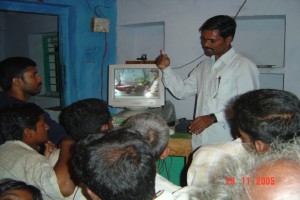
A village agri management centre in India. Photo by Tiruchelvam Ramu
Trieste (Italy): QU Dongyu, the Director-General of the Food and Agriculture Organization of the United Nations (FAO), today called for a closing of the digital divide and reiterated FAO’s commitment to promote the use of digital technologies, billing them essential for a much-needed transformation of the agri-food systems.
Speaking at the G20 Digital Economy Ministers’ meeting, Qu made a strong case for expanding the use of digital technologies, especially in rural areas, where such technologies could be leveraged to address multiple market failures (for example, information asymmetry on prices of produce and inputs, lack of access to financial services, search costs for traceability) and help smallholder farmers access markets. Rural women, in particular, stressed Qu, were most disadvantaged by the lack of connectivity.
“Connectivity has improved dramatically, but a digital divide remains between countries, between rural and urban areas,” said Qu.
According to the International Telecommunication Union (ITU), at the end of 2019, just over 51 per cent of the global population, or 4 billion people, were using the Internet. The Broadband Commission estimates that a $428 billion-investment is needed to ensure everyone is connected by 2030.
“Collectively, we cannot bear the immense cost of this digital divide. The COVID-19 pandemic has made it clear that now, more than ever, connectivity is a pre-condition for social inclusion,” said the FAO Director-General.
He also reiterated FAO’s commitment to working in partnership for more efficient, inclusive, resilient and sustainable agri-food systems to achieve better production, better nutrition, a better environment, and a better life, leaving no one behind – a transformation that would not be possible without digital technologies.
Qu went on to share examples of how FAO has been accelerating the uptake of digital technologies in the food and agriculture sectors, and the promotion of digital rural transformation.
Combatting hunger, poverty and inequality through digital technologies
FAO’s 1,000 Digital Villages Initiative focuses on converting 1,000 villages across the world into digital hubs – all with the aim of supporting the transformation of agri-food systems. The Initiative incorporates three main elements: “e-Agriculture” to improve agricultural productivity through ICT and digital solutions, such as climate smart, precision and intelligent facility agriculture; “Digital Farmer Services” to enhance farmers’ access to services, including financial services, social protection and employment; and digital services for “Rural transformation” to enhance the delivery of public services in health, education, jobs, welfare, eco- and agri-tourism.
Launched in July 2020, FAO’s Hand-in-Hand Geospatial Platform is a digital public good to create interactive data maps, analyse trends and identify real-time gaps and opportunities in the food and agriculture sectors, thus, guiding and ensuring impactful investments.
FAO also acts as a linchpin, bringing together a wide range of partners on the use of digital technologies in food and agriculture. In this respect, FAO’s soon-to-be-operational International Platform for Digital Food and Agriculture will provide a venue for dialogue, policy making, and strengthening of the linkages between agriculture and digital economy fora, supporting governments to enhance the benefits of digital agriculture and leapfrog by learning from their peers, while addressing potential concerns.
FAO, together with Pontifical Academy for Life, Microsoft, IBM and the Italian Ministry for Technological Innovation and Digital Transition, has also made The Call for AI Ethics to promote an ethical approach to artificial intelligence.
– global bihari bureau





